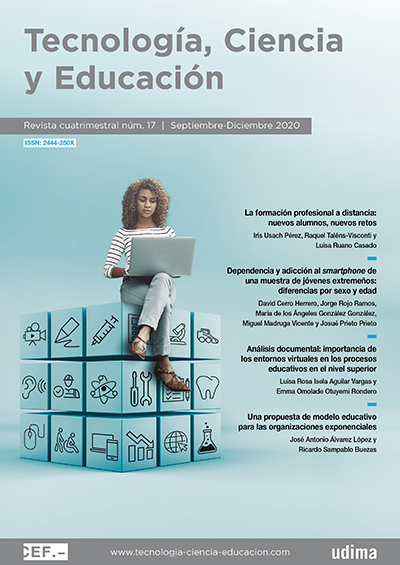Resolution of flow diagrams and pseudocode by students of Computer Science at the University of Costa Rica
DOI:
https://doi.org/10.51302/tce.2020.491Keywords:
cognitive science, diagrams, eye-tracking, meta-analysis, programming, pseudocodeAbstract
An eye tracking study was carried out on 20 students of Computer Science at the University of Costa Rica, half of the first year and the other half of the fourth year. They were asked to solve 10 flowchart and 10 pseudocode exercises. In the experts approximately half of the fixations focus on the most relevant areas of interest for the resolution of the problem, while in the rookies approximately one third of the fixations are concentrated in those areas. When calculating the density of fixations in the areas of interest this pattern is much more evident. Regarding performance, significant differences were observed between experts and novices, showing the first best performance. Regarding the duration of the resolution of the exercises, only significant differences were found between experts and novices when solving pseudocodes. Depending on the results obtained, recommendations are made for the teachers of the programming courses and for future research.
Downloads
References
Allaire, J., Xie, Y., Mc Pherson, J., Luraschi, J., Ushley, K., Atkins, A. y Wickham, H. (2020). Dynamic Documents for R. Recuperado de https://cran.r-project.org/web/packages/rmarkdown/rmarkdown.pdf (consultado el 16 de enero de 2020).
Andrzejewska, M., Stolinska, A., Blasiak, W., Peczkowski, P., Rosiek, R., Rozek, B., Sajka, L. y Wcislo, D. (2015). Eye-tracking verification of the strategy used to analyse algorithms expressed in a flowchart and pseudocode. Interactive Learning Environmets, 24(8), 1.981-1.995.
Aschwanden, C. y Crosby, M. (2006). Code scanning patterns in program comprehension. 39th Annual Hawaii International Conference on Systems.
Bednarik, R. (2012). Expertise dependent visual attention strategies develop over time during debugging with multiple code representations. International Journal of Human-Computer Studies, 70, 143-155.
Bednarik, R., Busjahn, T. y Schulte, C. (2014). Eye movements in programing education: analyzing the expert's gaze. Proceedings of the First International Workshop.
Cattell, R. y Cattell, A. (2015). Manual prueba factor G de Catell. Madrid: Tea Ediciones.
Dink, J. W. y Ferguson, B. (2015). EyetrackingR: An R Library for Eye-Tracking Data Analysis. Recuperado de http://www.eyetrackingr.com (consultado el 15 de enero de 2020).
Gegenfurther, A., Lehtinen, E. y Saljo, R. (2011). Expertise differences in the comprehension of visualizations: a meta-analysis of eye-tracking research in profesional domains. Educational Psychology Review, 23, 523-552.
Lin, Y., Wu, C., Hou, T., Lin, Y., Yang, F. y Chang, C. (2015). Tracking students cognitive processes during program debugging: an eye movement approach. IEEE Transactions on Education, 59(3), 175-186.
Pinales, F. y Velázquez, C. (2014). Algoritmos resueltos con diagramas de flujo y pseudocódigo. Aguascalientes, México: Universidad Autónoma de Aguascalientes.
Rueda, S. (2013). El desarrollo de la comprensión lectora en las carreras de informática. XVIII Congreso Argentino de Ciencias de la Computación. Departamento de Ciencias e Ingeniería de la Computación, Universidad Nacional del Sur.
SR Research. (2017). EyeLink Data Viewer User's Manual. Ontario, Canadá: SR Research.
Tierney, N., Cook, D., McBain, M. y Fay, C. (2020). Data Structures, Summaries and Visualisations for Missing Data. Recuperado de https://cran.r-project.org/web/packages/naniar/naniar.pdf (consultado el 17 de enero del 2020).
Tsapatsoulis, N. (2014). Learning Technologies & Open and Distance Learning. Nicosia, Chipre: University of Cyprus.
Wickham, H. y Grolemund, G. (2017). R for Data Science. EE. UU.: O'Reilly.
Wickham, H., Francois, R., Henry, L. y Muller, K. (2020). A Grammar of Data Manipulation. Recuperado de https://cran.r-project.org/web/packages/dplyr/dplyr.pdf (consultado el 18 de enero de 2020).
Wickham, H., Chang, W., Henry, L., Pedersen, T., Takahashi, K., Wilke, C. y Woo, K. (2020). Create Elegant Data Visualizations Using the Gramar of Graphics. Recuperado de https://cran.r-project.org/web/packages/ggplot2/ggplot2.pdf (consultado el 19 de enero de 2020).
Downloads
Published
How to Cite
Issue
Section
License
Copyright (c) 2020 Luis Andrés Villalobos Fernández, Álvaro de la Ossa Osegueda, Odir Antonio Rodríguez-Villagra, Adrián Esteban Vergara Heidke

This work is licensed under a Creative Commons Attribution-NonCommercial-NoDerivatives 4.0 International License.


























